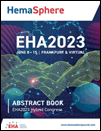P1371: COMPARISON OF DIFFERENT METHODS FOR GENETIC CORRECTION OF GRISCELLI SYNDROME TYPE II-DERIVED STEM CELLS
Abstract Topic: 24. Gene therapy, cellular immunotherapy and vaccination - Biology & Translational Research
Background: Griscelli Syndrome type 2 (GS-2) is a rare autosomal recessively inherited severe combined immunodeficiency, characterized by partial albinism with or without hemophagocytic lymphohistiocytosis (HLH). It is caused by mutations in the RAB27A gene resulting in mild neutropenia and markedly decreased NK cell and T cell cytotoxicity. Currently the only curative treatment is hematopoietic stem cell (HSC) transplantation.
Aims: Here, we aimed to develop gene therapy for correction of stem cells derived from two GS-2 patients with different mutations (exon 3 delAGinsC and exon 7 delCAAGC) in the RAB27A gene, using lentiviral (LV) constructs and CRISPR-Cas9 and assess the potential oncogenic effects of RAB27A overexpression.
Methods: GS-2 mesenchymal stem cells (MSCs) were transduced with using a polycistronic LV vector carrying the transcription factors OCT3/4, SOX2, KLF-4 and c-Myc. Induced pluripotent stem cells (iPSCs) were lentivirally transduced with codon optimized RAB27A (RAB27Aco) under the control of three different promoters (PGK, UCOE and SFFV). CRISPR constructs were designed to repair the respective mutations. After correction cells were assessed for RAB27A gene and protein expression. To assess possible development of leukemia, hematopoietic stem cells (HSCs) overexpressing RAB27A were transplanted into Rag2 deficient mice and followed for 6 months.
Results: Before correction RAB27A mutations were confirmed in the GS-2 iPSC and MSC cell lines. After correction RAB27A protein expression was detected using FACS and Western blot assays, gene expression was confirmed using qRT-PCR. Correction of the mutation was done using sequencing for the RAB27A gene. As expected, RAB27A expression was highest after transduction with the SFFV promoter, resulting in overexpression of the gene in 50-70% of the cells. Correction using CRISPR-Cas9 was successful in only one of the mutations (delAGinsC). At the interim analysis at three months post transplantation only low levels of RAB27A expression was detected in the peripheral blood of the mice, in the absence of any indications for leukemia. However, more detailed analyses will be performed at sacrifice of the mice at 6 months.
Summary/Conclusion: RAB27A gene and protein expression could be detected after LV transduction of GS-2 cells. Both LV gene addition and correction using CRISPR-Cas9 were successful. Interim analysis did not show evidence for leukemia after transplantation of cells overexpressing RAB27A.
Keywords: Hematopoietic stem cell, Lentiviral transduction, Stem cell gene therapy, Allogeneic hematopoietic stem cell transplant




